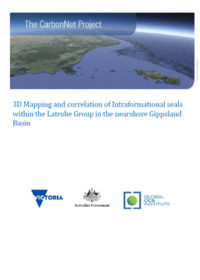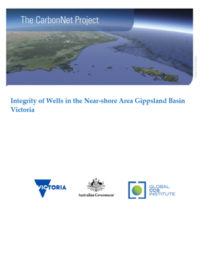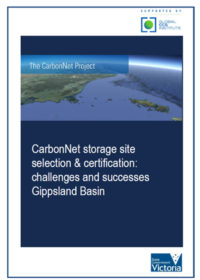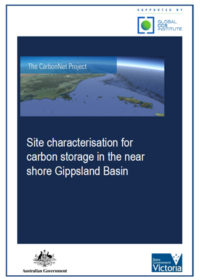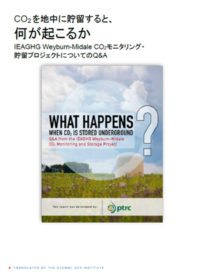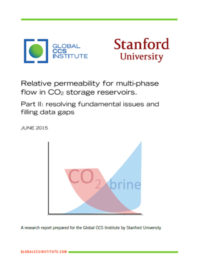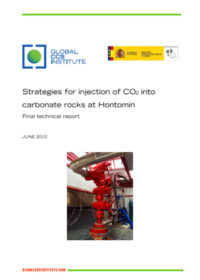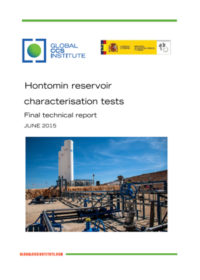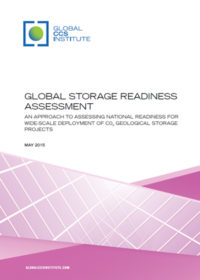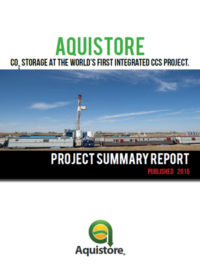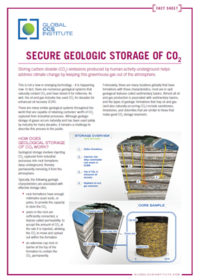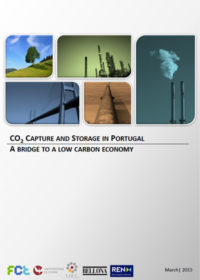Resources
Publications
Our publications, reports and research library hosts over 500 specialist reports and research papers on all topics associated with CCS.
View our Publication Library Disclaimer.
Filter by
The CarbonNet Project: 3D mapping and correlation of intraformational seals within the Latrobe Group in the nearshore Gippsland Basin
15th October 2015
Topic(s): Carbon capture use and storage (CCUS), CO2 storage
The Global CCS Institute presents the sixth report published by the CarbonNet Project, located in Victoria, Australia, this report has focussed on a critical aspect of CO2 storage - containment of the CO2. CarbonNet are investigating the potential for establishing a large scale, multi user CCS network bringing together multiple CO2 capture projects, transporting CO2 via a shared pipeline and injecting it deep into an underground, offshore storage site and is currently in feasibility and commercial definition stage.
The Gippsland Basin is known to have a world-class proven regional seal (or caprocks), known as the Lakes Entrance Formation it has stored oil and gas accumulations for tens of millions of years. This regional seal has always been identified as the final barrier to CO2 plume migration in any storage concept in the basin. This report has identified several additional, laterally extensive seals below the regional seal, known as the T2 seal. These additional sealing units are expected to provide an effective barrier to the CO2 injected into the primary storage targets below in the Halibut reservoirs. The T2 seals are proven to be effective containment rocks as they have previously retained oil and gas accumulations locally and nearby. Also, lab measurements on rock samples of the seal suggest they could hold back a column of CO2 in excess of what is expected to be required in the reservoirs below. This investigation has revealed there may be hundreds of gigatonnes of additional storage available and confirms that the Gippsland Basin is a world class storage site for CCS.
This report is authored by N. Hoffman , T. Evans, N. Arian, The CarbonNet Project, Melbourne, Australia; Guy Holdgate, University of Melbourne. Chris Consoli, Institute Senior Adviser for Storage, Asia-Pacific also provides an overview of the report in an Insight available on the Global CCS Institute website.
Disclaimer
The content within the Global CCS Institute Publications, Reports and Research Library is provided for information purposes only. We make every effort and take reasonable care to keep the content of this section up-to-date and error-free. However, we make no claim as to its accuracy, currency or reliability.
Content and material featured within this section of our website includes reports and research published by third parties. The content and material may include opinions and recommendations of third parties that do not reflect those held by the Global CCS Institute.
The CarbonNet Project: integrity of wells in the near-shore area Gippsland Basin Victoria
14th October 2015
Topic(s): Carbon capture use and storage (CCUS), CO2 storage
The Global CCS Institute presents this new report by CarbonNet evaluating the impact legacy petroleum wells may have on their search for CO2 storage sites in the nearshore Gippsland Basin. The CarbonNet Project is investigating the potential to establish a CCS Hub bringing together multiple CO2 capture projects in Victoria’s Latrobe Valley, transporting CO2 via a shared pipeline and injecting it into deep saline formations in the nearshore Gippsland Basin.
This report identified and then analysed legacy petroleum wells that may have an impact on the feasibility of CO2 storage sites targeted as future storage concepts. The analysis included using data lodged with the regulatory authority to assess how the legacy petroleum wells were ‘completed’. The investigation found that none of the wells have any significant risk of leakage and that there is negligible risk of CO2 rising to near-surface levels.
This report is authored by Todd Goebel, Nick Hoffman, Barry Nicholson, and The CarbonNet Project. Chris Consoli, Institute Senior Adviser for Storage, Asia-Pacific also provides an overview of the report in a new Insight available on the Global CCS Institute website.
Disclaimer
The content within the Global CCS Institute Publications, Reports and Research Library is provided for information purposes only. We make every effort and take reasonable care to keep the content of this section up-to-date and error-free. However, we make no claim as to its accuracy, currency or reliability.
Content and material featured within this section of our website includes reports and research published by third parties. The content and material may include opinions and recommendations of third parties that do not reflect those held by the Global CCS Institute.
The CarbonNet Project. CarbonNet storage site selection & certification: challenges and successes
14th September 2015
Topic(s): Carbon capture use and storage (CCUS), CO2 hubs, CO2 storage
The Global CCS Institute presents the second report by CarbonNet to identify and then characterise suitable storage sites in the offshore Gippsland Basin. The CarbonNet Project is investigating the potential to establish a CCS Hub bringing together multiple CO2 capture projects in Victoria’s Latrobe Valley, transporting CO2 via a shared pipeline and injecting it into the offshore Gippsland Basin.
This report details the history of the site selection process between 2010 and 2015. The search for a storage site has followed international best practice, aligned to DNV GL Recommended Practice (DNV-RP-J203) to provide decision makers and stakeholders with independent expert assurance of environmentally safe, long-term geological storage.
This report is authored by George Carman, Nick Hoffman, and the CarbonNet Project. Chris Consoli, Institute Senior Adviser for Storage, Asia-Pacific also provides an overview of the report in an Insight available on the Global CCS Institute website.
Disclaimer
The content within the Global CCS Institute Publications, Reports and Research Library is provided for information purposes only. We make every effort and take reasonable care to keep the content of this section up-to-date and error-free. However, we make no claim as to its accuracy, currency or reliability.
Content and material featured within this section of our website includes reports and research published by third parties. The content and material may include opinions and recommendations of third parties that do not reflect those held by the Global CCS Institute.
The CarbonNet Project: site characterisation for carbon storage in the near shore Gippsland Basin
7th September 2015
Topic(s): Carbon capture use and storage (CCUS), CO2 storage
The Global CCS Institute presents a carbon dioxide (CO2) storage site characterisation study for the CarbonNet Project. The CarbonNet project is investigating the potential to establish a CCS Hub bringing together multiple CO2 capture projects in Victoria’s Latrobe Valley, transporting CO2 via a shared pipeline and injecting it into the offshore Gippsland Basin. The report details the steps taken during the screening of potential storage sites in the offshore Gippsland Basin.
Three of the highest ranked sites are identified and their geological characteristics detailed and suitability for CO2 storage are described. The report found that all three storage sites are located nearshore and have the potential to dispose of between 25 and 15 Mt of CO2 permanently in deep saline formations.
This report is authored by Nick Hoffman, George Carman, Mohammad Bagheri, Todd Goebel; and the CarbonNet Project for the Global CCS Institute. Chris Consoli, Institute Senior Adviser for Storage, Asia-Pacific also provides an overview of the report in a new Insight available on the Global CCS Institute website.
Disclaimer
The content within the Global CCS Institute Publications, Reports and Research Library is provided for information purposes only. We make every effort and take reasonable care to keep the content of this section up-to-date and error-free. However, we make no claim as to its accuracy, currency or reliability.
Content and material featured within this section of our website includes reports and research published by third parties. The content and material may include opinions and recommendations of third parties that do not reflect those held by the Global CCS Institute.
CO2を地中に貯留すると、何が起こるか – IEAGHG Weyburn-Midale CO2モニタリング・貯留プロジェクトについてのQ&A
4th September 2015
Topic(s): Carbon capture use and storage (CCUS), CO2 storage, Health safety and environment
IEAGHG Weyburn-Midale CO2モニタリング・貯留プロジェクトは、カナダ・サスカチェワン州南東の石油埋蔵地貯留所へのCO2圧入および貯留効果を調査するために設計された研究プログラムである。「CO2を地中に貯留すると、何が起こるか」は、CCSについて一般市民から頻繁に寄せられる質問に対し、上記プロジェクトから得られた広範囲に及ぶデータおよび調査結果に基づく回答をまとめたものである。
Japanese translation of What happens when CO2 is stored underground? Q&A from the IEAGHG Weyburn-Midale CO2 Monitoring and Storage Project.
Disclaimer
The content within the Global CCS Institute Publications, Reports and Research Library is provided for information purposes only. We make every effort and take reasonable care to keep the content of this section up-to-date and error-free. However, we make no claim as to its accuracy, currency or reliability.
Content and material featured within this section of our website includes reports and research published by third parties. The content and material may include opinions and recommendations of third parties that do not reflect those held by the Global CCS Institute.
Relative permeability for multi-phase flow in CO2 storage reservoirs. Part II: resolving fundamental issues and filling data gaps
30th June 2015
Topic(s): Carbon capture use and storage (CCUS), CO2 storage
This report, prepared for the Global CCS Institute by a consortium of research organisations led by Stanford University, presents an assessment of fundamental issues pertaining to the relative permeability of brine and carbon dioxide (CO2) systems. This research follows an earlier report published by the Institute in August 2013 which provided an overview of this topic and highlighted knowledge gaps.
Relative permeability is an important factor in determining the fate and transport of CO2 over the lifetime of a storage project. To date only limited information on this critical factor has been available, much of which is summarised in the 2013 report. This report addresses key gaps in knowledge and data related to CO2 storage in saline formations.
Disclaimer
The content within the Global CCS Institute Publications, Reports and Research Library is provided for information purposes only. We make every effort and take reasonable care to keep the content of this section up-to-date and error-free. However, we make no claim as to its accuracy, currency or reliability.
Content and material featured within this section of our website includes reports and research published by third parties. The content and material may include opinions and recommendations of third parties that do not reflect those held by the Global CCS Institute.
Strategies for injection of CO2 into carbonate rocks at Hontomin: final technical report
29th June 2015
Topic(s): Carbon capture use and storage (CCUS), CO2 storage
This is a technical report examining the different strategies used for injection of CO2 into Carbonate Rocks at the Hontomin CO2 Storage Project in North West Spain. The report is authored by the CO2 injection team at CIUDEN (or Fundación Ciudad de la Energía – Spain's publicly funded energy research foundation), in collaboration with the Ground Water Hydrology Group of UPC-CSIC Barcelona.
The report aims to give an overview of current thinking around CO2, carbonate rocks and their interaction, before going into detailed description of the various CO2 injection strategies employed at the Hontomin test injection site.
A summary of the literature on CO2 thermodynamics, and a high level overview of the large volumes of literature on carbonate rocks and their interactions is provided, along with analysis of the performance and interpretation of simulation models and laboratory tests on the dynamics of CO2 injection and storage in carbonate rocks.
The report goes on to describe strategies for CO2 injection into carbonate formations, specifically focusing on:
- Push-pull tests
- Supercritical injection
- Liquid phase injection
- Pulsed (intermittent) injection
For each strategy, the shape and size of the CO2 plume and operational conditions for low permeability formations, are analysed. Mechanical stability issues are also discussed. It is hoped that the publication of these results from the Hontomin test injections, will contribute to the development of key site characterization techniques and the improvement of modelling approaches and field scale tests for evaluation of different CO2 injection strategies.
This report is published in connection with a further technical report from the CIUDEN team in Hontomin - Hontomin Reservoir characterization tests – and to a suite of bilingual community outreach and education initiatives created and delivered in the communities around the Hontomin site before, during and after construction of the injection site.
Disclaimer
The content within the Global CCS Institute Publications, Reports and Research Library is provided for information purposes only. We make every effort and take reasonable care to keep the content of this section up-to-date and error-free. However, we make no claim as to its accuracy, currency or reliability.
Content and material featured within this section of our website includes reports and research published by third parties. The content and material may include opinions and recommendations of third parties that do not reflect those held by the Global CCS Institute.
Hontomin Reservoir characterisation tests: final technical report
29th June 2015
Topic(s): Carbon capture use and storage (CCUS), CO2 storage
This is a technical report cataloguing the reservoir characterisation techniques emerging from the Hontomin CO2 Storage Project in North West Spain. The report is authored by the CO2 injection team at CIUDEN (or Fundación Ciudad de la Energía - Spain's publicly funded energy research foundation), in collaboration with the Ground Water Hydrology Group of UPC-CSIC Barcelona.
Building on existing research into CO2 injection into low permeability carbonates for enhanced oil recovery (CO2 -EOR) operations in North America, the Hontomin site provides an opportunity in Europe to develop injection and CO2 storage-related activities in a low permeability, carbonate deep saline aquifer. This novel approach for dedicated geological storage could provide learnings for potential storage operations in other sites of low permeability.
This report is published in connection with a further technical report from the CIUDEN team in Hontomin - Strategies for injection of CO2 into Carbonate Rocks at Hontomin – and to a suite of bilingual community outreach and education initiatives created and delivered in the communities around the Hontomin site before, during and after construction of the injection site.
Disclaimer
The content within the Global CCS Institute Publications, Reports and Research Library is provided for information purposes only. We make every effort and take reasonable care to keep the content of this section up-to-date and error-free. However, we make no claim as to its accuracy, currency or reliability.
Content and material featured within this section of our website includes reports and research published by third parties. The content and material may include opinions and recommendations of third parties that do not reflect those held by the Global CCS Institute.
Global storage readiness assessment: an approach to assessing national readiness for wide-scale deployment of CO2 geological storage projects
29th May 2015
Topic(s): Carbon capture use and storage (CCUS), CO2 storage, Policy law and regulation
Lead Author Christopher P Consoli presents this methodology that assesses any given nation’s readiness for large-scale carbon dioxide (CO2) geological storage projects, as part of the wide-scale deployment of carbon capture and storage (CCS) projects. The Global CCS Institute’s assessment method enables a consistent and repeatable framework using a weighted set of criteria for transparency and accountability that can be updated as necessary to revise assessments and to include new nations.
This storage assessment complements the CCS Policy Indicator (CCS-PI) previously published by the Global CCS Institute in 2013 to compare levels of national policy support for CCS. Together, these two assessments work to highlight the global progression of CCS. This assessment is a living document designed to reflect the evolution of CCS and will be updated regularly.
Disclaimer
The content within the Global CCS Institute Publications, Reports and Research Library is provided for information purposes only. We make every effort and take reasonable care to keep the content of this section up-to-date and error-free. However, we make no claim as to its accuracy, currency or reliability.
Content and material featured within this section of our website includes reports and research published by third parties. The content and material may include opinions and recommendations of third parties that do not reflect those held by the Global CCS Institute.
Aquistore: CO2 storage at the world’s first integrated CCS project. Project summary report
18th May 2015
Topic(s): Carbon capture use and storage (CCUS), CO2 storage
The Global CCS Institute commissioned the Petroleum Technology Research Centre (PTRC) in 2013 to provide a summary report on the Aquistore project, a CO2 geological storage site located near the town of Estevan in southern Saskatchewan, Canada. Aquistore will be used by owner/operator SaskPower as a dedicated geological storage option for CO2 captured from the nearby Boundary Dam Power Station - the location of the world’s first commercial scale post-combustion capture of CO2 from coal fired power generation.
Disclaimer
The content within the Global CCS Institute Publications, Reports and Research Library is provided for information purposes only. We make every effort and take reasonable care to keep the content of this section up-to-date and error-free. However, we make no claim as to its accuracy, currency or reliability.
Content and material featured within this section of our website includes reports and research published by third parties. The content and material may include opinions and recommendations of third parties that do not reflect those held by the Global CCS Institute.
Secure geologic storage of CO2
5th May 2015
Topic(s): Carbon capture use and storage (CCUS), CO2 storage
This fact sheet by the Global CCS Institute provides an overview of the different types of storage options available for captured carbon dioxide emissions.
Disclaimer
The content within the Global CCS Institute Publications, Reports and Research Library is provided for information purposes only. We make every effort and take reasonable care to keep the content of this section up-to-date and error-free. However, we make no claim as to its accuracy, currency or reliability.
Content and material featured within this section of our website includes reports and research published by third parties. The content and material may include opinions and recommendations of third parties that do not reflect those held by the Global CCS Institute.
CO2 capture and storage in Portugal: a bridge to a low carbon economy
1st April 2015
Topic(s): Carbon capture use and storage (CCUS), CO2 capture, CO2 storage, Economics
This report evaluates the role the CCS technology could play in the Portuguese energy and industry system as a mitigation option to achieve deep GHG emissions reductions. The cost effectiveness of its deployment, and the risks and additional benefits it may provide for economic development are also analysed.
The partners of the CCS-PT: Perspectives for capture and sequestration of CO2 in Portugal project authored this report:
- CENSE Research Group, FCT - Universidade Nova de Lisboa
- CGE Research Group, Universidade de Évora
- Laboratório Nacional de Energia e Geologia
- REN – Rede Eléctrica Nacional, S.A.
- Bellona Foundation
The Global CCS Institute supplied financial and technical contributions.
Sumário (Portuguese Summary)
O presente relatório avalia o papel que a tecnologia de CAC poderá desempenhar no sistema energético e industrial Português para atingir reduções significativas de emissões de GEE. São analisadas as condições que determinam o seu custo-eficácia, e os riscos e benefícios adicionais.
Disclaimer
The content within the Global CCS Institute Publications, Reports and Research Library is provided for information purposes only. We make every effort and take reasonable care to keep the content of this section up-to-date and error-free. However, we make no claim as to its accuracy, currency or reliability.
Content and material featured within this section of our website includes reports and research published by third parties. The content and material may include opinions and recommendations of third parties that do not reflect those held by the Global CCS Institute.
